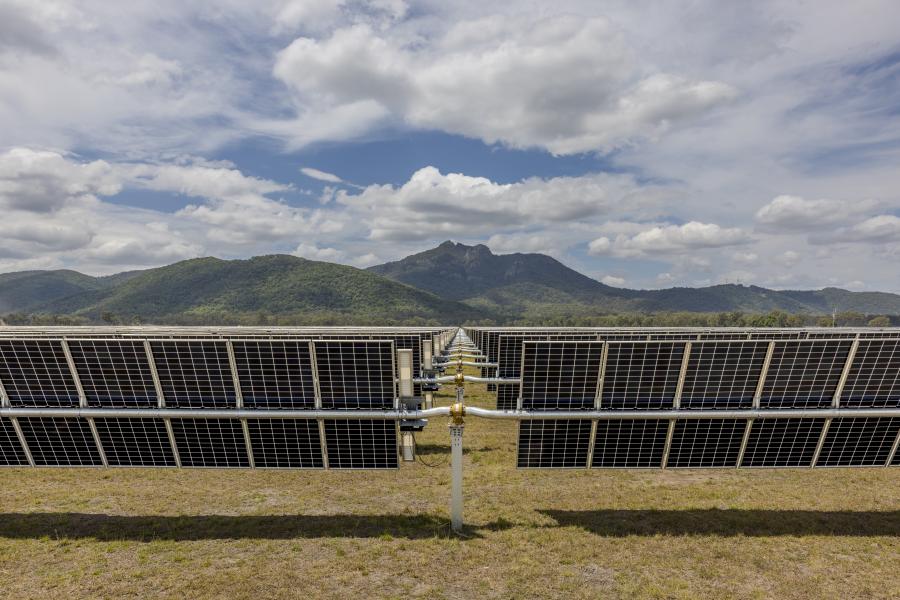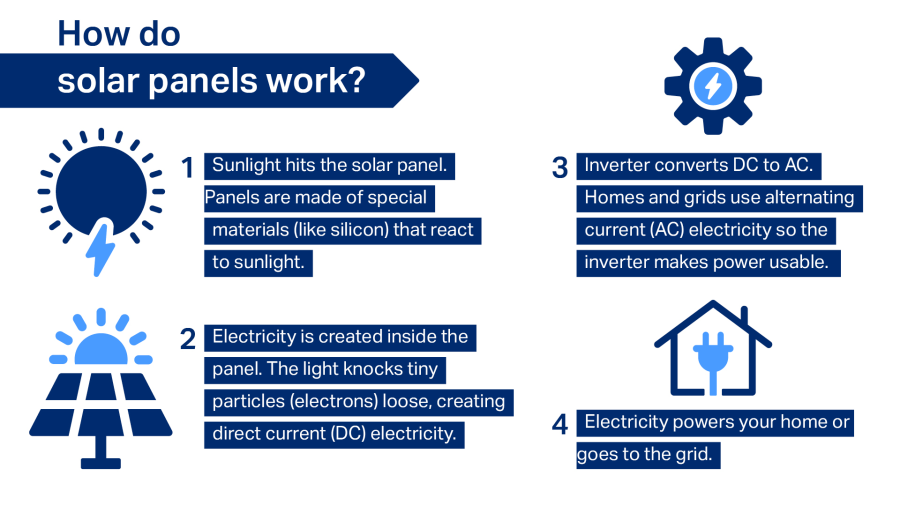Turning sunlight into electricity: how does solar power work?

Solar power is a crucial part of Australia’s energy transition. But what exactly is it, and how does it work?
What is solar power?
Solar power is produced when energy from the sun is transformed into electricity or used to heat air, water or other substances.
There are two main types of solar power technology, solar photovoltaic (PV) and solar thermal.

Solar photovoltaic
Solar photovoltaic converts sunlight directly into electricity using a technology known as a semiconductor cell or PV cell.
Typical solar PV cells are covered in glass protected by an aluminium frame, known as a solar panel. When sunlight hits a solar panel, it excites electrons in the cells, creating an electric current. This direct current is then converted into alternating current by an inverter for use in homes and businesses.
Solar thermal
Solar thermal refers to technology that uses sunlight to generate heat, rather than electricity.
There are two types of solar thermal systems:
- Small scale thermal technology refers to systems that use heat energy on a small or localised scale, such as a solar hot water system.
- Concentrated solar thermal (CST) harvests the suns heat to produce large-scale power generation. It uses a field of mirrors to reflect sunlight onto a receiver, which transfers the heat to a thermal energy storage system.
Solar PV is currently the most used solar technology in Australia and globally. CST uptake in Australia and across the globe, has been relatively low in comparison to solar PV and wind mostly due to its higher cost.
What is large-scale solar?
Large-scale solar (LSS) refers to solar power systems that are much bigger than typical residential or commercial rooftop setups, often called solar farms or solar plants. They can generate anywhere from hundreds of kilowatts (kW) to thousands of megawatts (MW) of solar power.
What is small-scale solar?
Small-scale solar, like rooftop systems provide clean, renewable energy directly to homes and businesses. A typical home solar system might include 19 350-Watt panels, which would be 6,650 Watts or 6.65 kW.
The small-scale renewable energy scheme is an Australian Government initiative, which provides households and businesses a financial incentive to install small-scale renewable energy systems such as rooftop solar panels.
Rooftop solar is the second largest source of renewable electricity generation in Australia. In 2023, rooftop solar accounted for 11.2 per cent of Australia’s electricity supply according to the Clean Energy Council’s rooftop solar and storage report.
What are some large-scale solar energy projects happening in Australia?
In regional hubs like Central Queensland and the Hunter region, there are numerous solar developments helping to drive the transition.
- Aldoga Solar Farm is a solar farm project by Spanish renewable energy developer, ACCIONA Energia. It is located approximately 20 km north-west of Gladstone. The 380 MW PV plant is comprised of about 820,000 solar modules and is the first project of its kind in Queensland to incorporate Australian-made steel. ACCIONA has partnered with global solar equipment provider, Nextracker to use tubing for solar panel mounts made from Australian steel at the Orrcon Steel facility in Brisbane.
- Goulburn River Solar Farm project consists of a 585 MW solar farm and battery energy storage system (BESS), located between Wollar and Merriwa, in the Upper Hunter Region of NSW. When operational, it will power about 191,000 homes annually and stabilise the grid at night.
- The CSIRO Concentrated Solar Thermal Facility located at the Newcastle Energy Centre is exploring new ways of capturing thermal energy from sunlight.
How do solar energy projects benefit regions?
Aside from helping regions to meet their energy needs, solar farm projects offer a range of social and economic benefits.
- Job creation – solar farm projects create job opportunities, especially during their construction. The Aldoga Solar Farm generated 350 jobs during its construction and will provide up to 10 ongoing fulltime positions on site once operational. The Goulburn River Solar Farm will create up to 350 jobs during the construction phase and up to 10 jobs will be generated during the operational phase.
- Support the local economy beyond jobs – solar farms stimulate the local economy through land lease payments, property taxes, and the purchase of goods from local businesses such as construction materials and equipment.
- The Aldoga Solar Farm is one example of a solar farm project supporting the Gladstone community Aside from generating jobs, the project will procure up to $150 million in goods and services from local businesses and suppliers and it will invest back into the community with a $120,000 annual community benefit fund made available to support various local programs and organisations.
